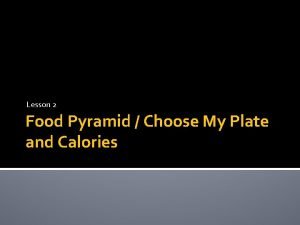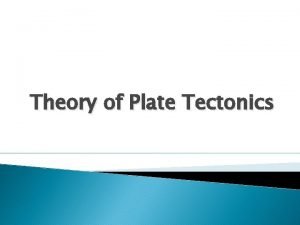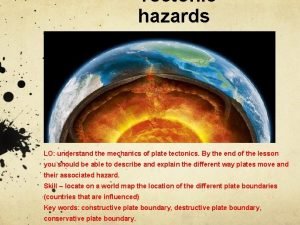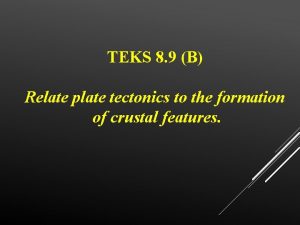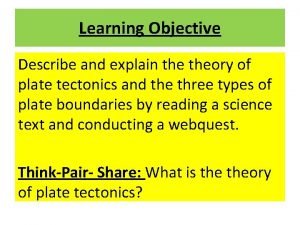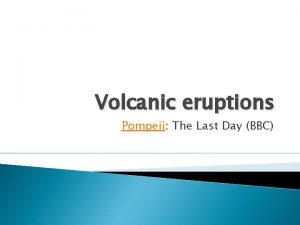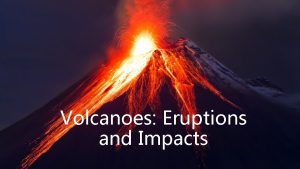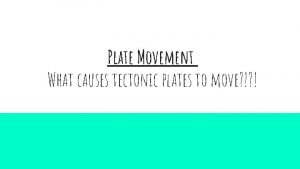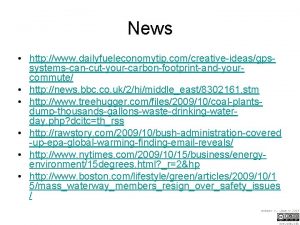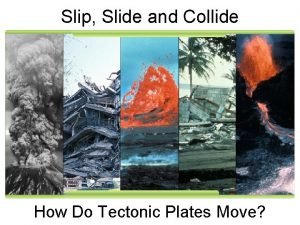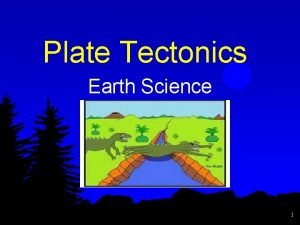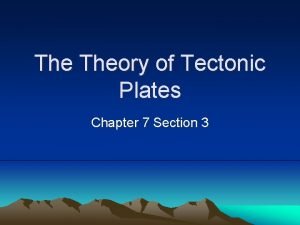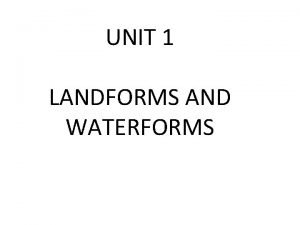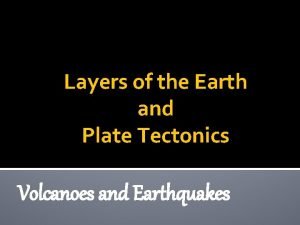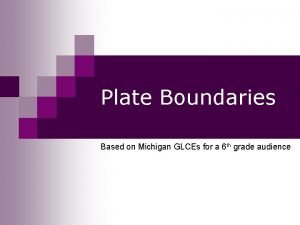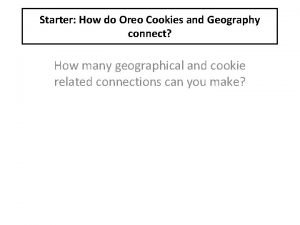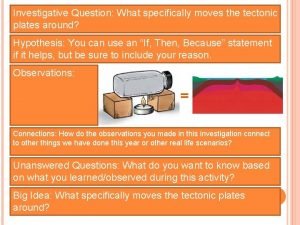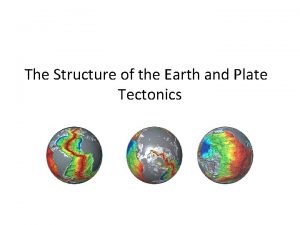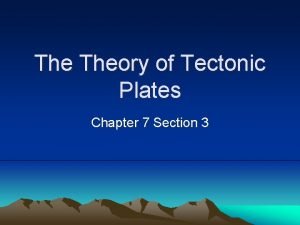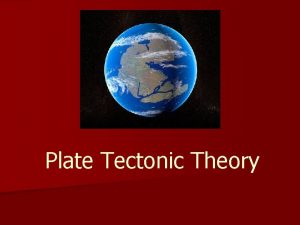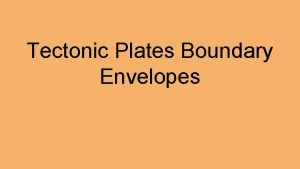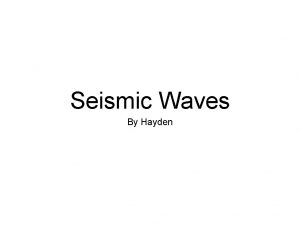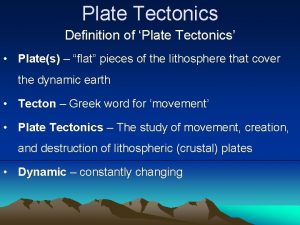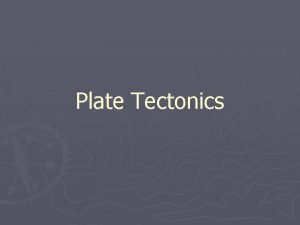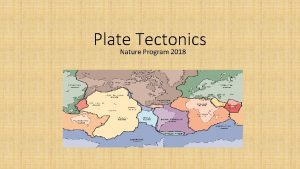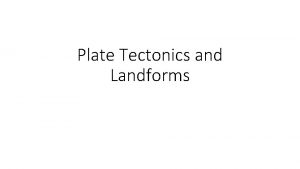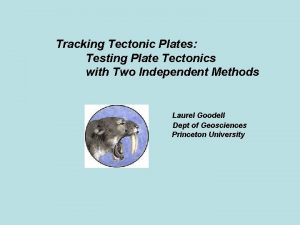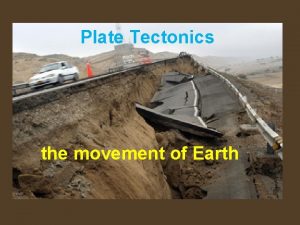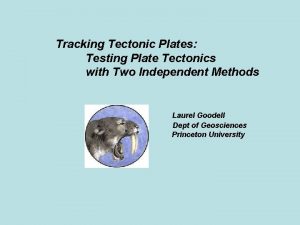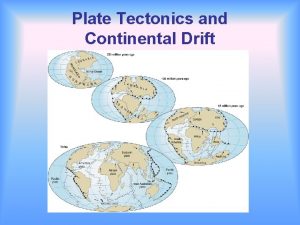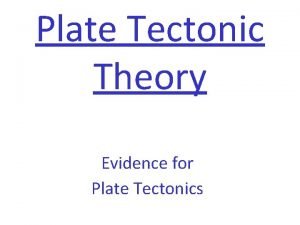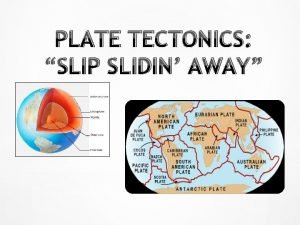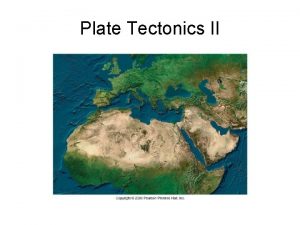CH 7 PLATE TECTONICS Tectonic Plates pieces of
























- Slides: 24

CH. 7 PLATE TECTONICS Tectonic Plates -pieces of lithosphere that move around on the asthenosphere -plates fit together like a puzzle -plates are not divided along continent lines

How do scientists Map the Earth’s Interior? -when quakes happen-seismic waves travel thru earth at different speeds -speed depends on density & composition of material they go through (faster thru solids & slower thru liquids) -seismographs measure vibrations (seismic waves) & use distances from epicenter & wave travel time to calculate density & thickness of each layer of the earth

COMPOSITION OF THE EARTH Crust, Mantle, Core Layers are based on chemical composition: crust is made of less dense compounds (O, Si, Al) core is made of denser compounds (Fe, & some N)

5 PHYSICAL LAYERS OF THE EARTH & THEIR PROPERTIES Lithosphere: made up of crust & rigid upper mantle & is divided into tectonic plates Asthenosphere: a plastic, soft layer of mantle on which lithospheric plates move Mesosphere: Outer Inner strong, lower part of mantle to core: liquid layer of core below mantle core: solid, dense center of Earth

MAJOR TECTONIC PLATES

MOVEMENT OF TECTONIC PLATES

CHAPTER 7. 2 NOTES: RESTLESS CONTINENTS 1910 - Alfred Wegener developed the Continental Drift hypothesis *Hypothesis states that 245 million years ago the continents once formed a super continent (Pangaea) when reptiles, winged insects, and great tropical forests which formed coal deposits, covered large parts of the Earth’s surface.

Wegener published his evidence to support the Continental Drift 1. Evidence from Landforms: -piece together Africa & S. America & mountain ranges line up where the continents join. -European coal fields match up with coal fields in N. America. 2. Evidence from Fossils: -fossils of Mesosaurus & Lystrosaurus have been found in places now separated by oceans. -Glossopteris (fern) lived 250 mill. yrs. ago and appears on separated landmasses of Africa, S. Amer. , Australia, India, & Antarctica. 3. Evidence from climate: -island of Spitsbergen in Arctic Ocean is ice-covered & harsh polar climate, but evidence of tropical plants from a warm climate 300 mill. years ago found there.

Wegener’s hypothesis was not accepted b/c he couldn’t explain the force that moves the continents. Many geologists (from 1920’s to 1960’s) believed Earth was slowly cooling & shrinking & mountains formed when the crust wrinkled like the skin of a dried-up apple. Wegener disputed this by stating that if this were true, then mountains would be found everywhere instead of the edges of continents. Also, they knew that by the strength of rock it wasn’t possible for the crust to move.

Scientists theorize that supercontinents occur in cycles 500 mill. yrs. before Pangaea, a supercontinent (Rodinia) existed 245 mill. yrs. ago Pangaea existed 135 mill. yrs. ago Pangaea split up into 2 huge continents (Laurasia & Gonwana) 65 mill. yrs. ago, split again to form present day continents

In 1960, Harry Hess, supported Wegener’s hypothesis Hess proposed sea-floor spreading (that at the mid-ocean ridge, sea floors moved like conveyor belts carrying the continents with them) -Mid-ocean ridges--underwater mountain chains that run thru center of Atl. Oceancracks in ocean crust allow molten material to spread out, pushing older rock to both sides of the ridge

Evidence of sea-floor spreading: 1. Evidence from molten material-scientists dived to mid-ocean ridge in Alvin (submersible) & found pillow rocks formed when molten material hardens quickly after erupting under water. 2. Evidence from magnetic pole reversal: throughout history, north & south magnetic poles have reversed themselves several times. Last happened 780, 000 years ago. Scientists found that the ocean floor rock with iron bits in them lined up in the direction of Earth’s magnetic poles & lie in a pattern of magnetized stripes which hold a record of reversals.

Ch. 7. 3 notes: Theory of Plate Tectonics All tectonic plates share boundaries w/other tectonic plates where they collide, separate, or slide past each other.

3 Types of Plate Boundaries 1. )CONVERGENT BOUNDARIES: when 2 plates collide (converge) their density determines which one comes out on top. Types of Convergent Boundaries: A) continental/continental-plates crash head on & create mountain ranges B) continental/oceanic--denser oceanic plate subducts under continental plate at a subduction zone. C) oceanic/oceanic--the denser plate is subducted thru a trench & returned to mantle.

2. ) DIVERGENT BOUNDARIES: when 2 plates separate new sea floor forms. -Most divergent boundaries form at mid-ocean ridges. -Divergent boundaries on land form rift valleys. 3. ) TRANSFORM BOUNDARIES: 2 plates slip past each other in opposite directions & crust is neither created or destroyed. *Earthquakes occur. (ex. San Andres Fault)

What causes tectonic plates to move? -plates float on the asthenosphere -heat from the earth’s core is the driving force of plate movement -heat of core causes convection currents (flow of currents heats rock, it rises & cools, then sinks which causes movement)

How fast do tectonic plates move? The movement is measured in cm/year (between 1 -10 cm/year) *which is about as fast as your fingernails grow. To measure the speed plates move: scientists use a system of GPS satellites to record the exact distance between the satellites & the ground. Over time distances change & can record the time it takes for GPS to move the distance to get speed of plates.

Critical thinking: On average, North America is moving 1. 25 cm/year away from the Mid-Atlantic ridge. Using this rate, determine how far apart the continents of North America & Africa will be after 200 million years? (Hint: distance = rate x time) *Remember that they are both moving away at that rate! (b/c both plates are moving away, you must multiply the rate by 2) 1. 25 cm/year x 2 = 2. 5 cm /year D=Rx. T D = 2. 5 cm/yr x 200, 000 yrs

ANSWER: 500, 000 CM OR _______ KM

Chapter 7. 4 Notes Deformation of the Earth’s Crust Deformation: any stress (pushing or pulling) on the crust which changes the volume/shape of crust Two types of deformation tension: stress when forces stretch an object compression: stress when an object is squeezed

Folding: bending of rock layers b/c of stress Types of folding anticlines: a fold in rock that bends upward into an arch syncline: a fold in rock that bends downward in the middle monocline: folded rock layers where both ends of the fold are horizontal

Faulting: occurs along plate boundaries where rocks break & slide past each other Three types of faults Normal Faults: occur when tectonic forces cause tension that pulls rocks apart & hanging wall slips downward past the footwall Reverse Faults: happen when tectonic forces cause compression that pushes rocks together & hanging wall slides up & over the footwall. Stike-Slip Fault: form when opposing forces cause rock to slip past each other sideways with little up/down motion. Ex. San Andres Fault in CA.

When tectonic plates undergo compression or tension, they form mountains several ways: Folded Mountains: form at convergent boundaries where continents collide. Ex. Appalacian Mts. formed when N. Amer. & Africa collided. Fault-Block Mountains: occur when tension causes large blocks of crust to drop down. Ex. Tetons in Wyoming Volcanic Mountains: located at convergent boundaries where oceanic plates sink at subduction zones & under the sea to sometimes cause islands. Ex. majority of volcanic mts. are formed around rim of Pacific Ocean Ring of Fire.

Types of movement in the crust: 1. Uplifting of Depressed Rock: -rising of regions of the crust to higher elevations. *Mountains form or areas rise or rebound when weight on it is removed. 2. Subsidence of Cooler Rocks: -sinking of regions of crust to lower elevations. *when lithosphere is hot, it takes up more space at mid-ocean ridge *lithosphere away from ridge is cooler, denser, & takes up less space, so oceanic lithosphere crust subsides. 3. Tectonic letdown: lithosphere is stretched in rift zones & stress causes faults to form & blocks of crust subside
 My plates pyramid tectonic plates
My plates pyramid tectonic plates Tectonic plates interact at places called plate
Tectonic plates interact at places called plate Tectonic plates move
Tectonic plates move Convergent divergent
Convergent divergent Transform fault
Transform fault Pompeii the last day bbc
Pompeii the last day bbc Shield volcano
Shield volcano What causes tectonic plates to move
What causes tectonic plates to move What causes tectonic plates to move? *
What causes tectonic plates to move? * Transform fault
Transform fault Transform
Transform Tectonic plates with names
Tectonic plates with names Tectonic plates
Tectonic plates What causes tectonic plates to move? *
What causes tectonic plates to move? * Convection cells
Convection cells Earth's foldable layers
Earth's foldable layers Divergent boundary oreo
Divergent boundary oreo Focus and epicenter of an earthquake
Focus and epicenter of an earthquake Is michigan on a tectonic plate boundary
Is michigan on a tectonic plate boundary Oreo cookie plate tectonics lab answers
Oreo cookie plate tectonics lab answers Example of an investigative question
Example of an investigative question Fun facts about tectonic plates
Fun facts about tectonic plates Ring of fire
Ring of fire Struture of the earth
Struture of the earth What is the main cause of tectonic plate movement
What is the main cause of tectonic plate movement
